The cutthroat trout surfaced 100 feet below me, in a slick run where the creek worked its way along a steep talus slope. The fish was out of reach, for the moment. I had just broken out of dark timber, the horse picking its way carefully across the scree, and I could look down through the tops of the tall Engelmann spruce to the pool where I thought a trout might live—and in that moment, the cutthroat showed its cards. The water was clear, and I had an -osprey’s-eye view from my saddle: I saw the big fish rise 5 or 6 feet through the water column, suck in a bug, and turn back like a copper-colored shooting star toward the stream bottom.
I stared at a spot where three downed trees crowded the creek’s flow, and I made an unlikely promise to myself: Four days from now, on the ride out, I was going to catch that trout.

Outfitter Bill Hanlon comes to a crest en route to the next fishing stop Tom Fowlks
In the interim, though, I had a job to do. With my friend Bill Hanlon and photographer Tom Fowlks, I was on a lake-hopping horse-pack trip through the southern British Columbia wilds, along the border of Height of the Rockies Provincial Park, where spires of -glacier-clad peaks rise to 12,000 feet. We were there to fish, but I also hoped to experience how one of North America’s most cherished wilderness traditions—horse packing—has helped define the very concept of wilderness. Hanlon, a 62-year-old retired shop teacher from Sparwood, B.C., is the most experienced horseman I know. He routinely loads up his string for two- and three-week hunting and fishing trips. He’s an outspoken advocate for wilderness conservation and the preservation of horse-packing culture. Tall and lanky and preternaturally cheerful, he’s even married to a former Miss Rodeo Canada. The man has trail cred.
At a remote trailhead, we loaded up two packhorses and saddled three others, then struck out into a wilderness valley with trout-filled alpine lakes and streams that rarely see a fly.
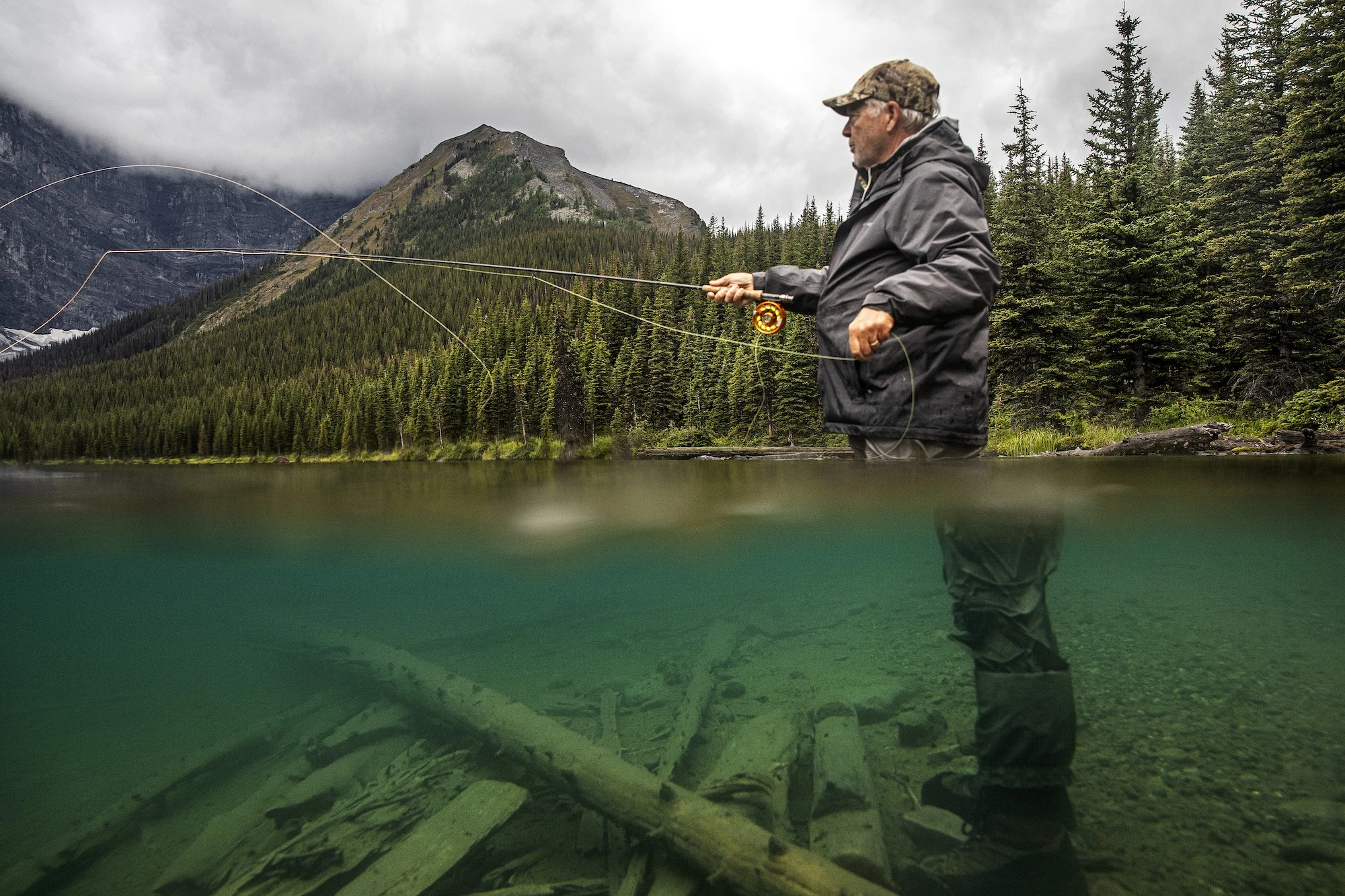
The author fires a cast in the clear lake water during a break in the rain. Tom Fowlks
The valley was also filled with rain. Lots of rain. But that’s part of the game in backcountry travel. Hanlon might be able to tie a one-man diamond hitch and lead a few horse-packing newbies to trout water, but even he couldn’t do much about the weather.
All the Pretty Packhorses
“How you doing, Eddie?” Hanlon called. I knew before I looked up that he was not inquiring about my well-being. Silhouetted against snowy cliff walls that rose 1,500 feet toward a jagged, crenellated rim, he was wearing blue jeans and a white cowboy hat, his blue heeler, Hitch, beside him. Hanlon was holding up a fly rod and a bruiser of a cutthroat trout.
“Didn’t realize we were supposed to be catching big ones,” I hollered back. “I thought you wanted pan-size trout for dinner.” Hanlon’s laugh echoed across the water.
I’d yet to catch a fish, but in my defense, it was tough to see the fly on the lake surface with all the glare from the glaciers on the water, and the temptation of looking for Stone sheep in the soaring gray cliffs above the lake. It had been like that all the way up the valley—scenery so wild and raw it was hard to concentrate on what I was doing. We’d ridden to the lake through a valley suffused in fog, past grizzly rubs where bears had marked trees with tooth and claw, picking across slab rocks and scree as the animals’ hooves clicked and clattered in a hypnotic rhythm of horse music. It’s part of the allure of traveling by horse—to feel so immersed in a landscape and see the world from a different perspective. Literally and figuratively.
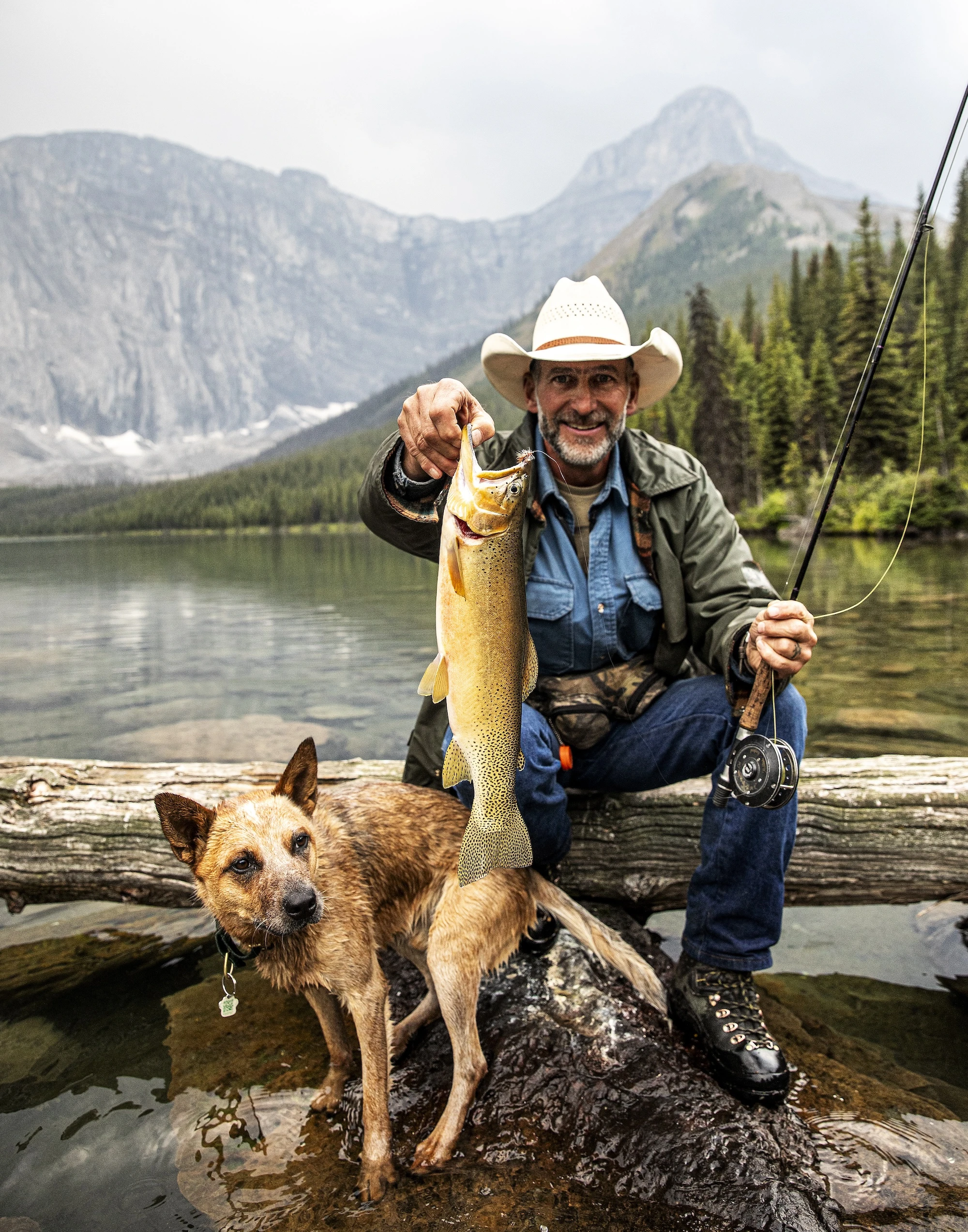
Hanlon shows off a trophy cutthroat caught from an alpine lake. Tom Fowlks
At breakfast earlier that morning, Hanlon had explained his attraction to long-distance horse packing. He is fascinated with Genghis Khan’s mounted warriors, who could ride for 10 days straight and subsist on little more than dried milk and blood from their horses. He’s devoured the books of the writer and explorer Jonathan Turk, whose epic journeys—mountain biking across the western Gobi Desert of Mongolia, circumnavigating Ellesmere Island by sea kayak (at the age of 65!)—have fueled his own passion for arduous journey. He lives within striking distance of some of the greatest wildernesses left on the continent—a region of the Kootenays locals call the Hornaday Wilderness, and the Muskwa-Kechika Management Area in northern British Columbia, an area of 50 intact watersheds managed for wilderness values that is nearly the size of Ireland. He hopes one day to join the Long Riders’ Guild, an international association open only to those who have ridden more than 1,000 miles on a single equestrian journey.
At times on the trail, Hanlon would dismount to saw through a tree branch or clear a downed fir. He and a small group of horse packers manage trails in this area specifically for equestrian travel, not necessarily for hikers or mountain bikers or llamas. They clear away brush 6 and 7 feet above the ground, at the height of a mounted traveler. It’s a distinction that Hanlon describes as “a conservation-first approach, not a fun-first approach.”
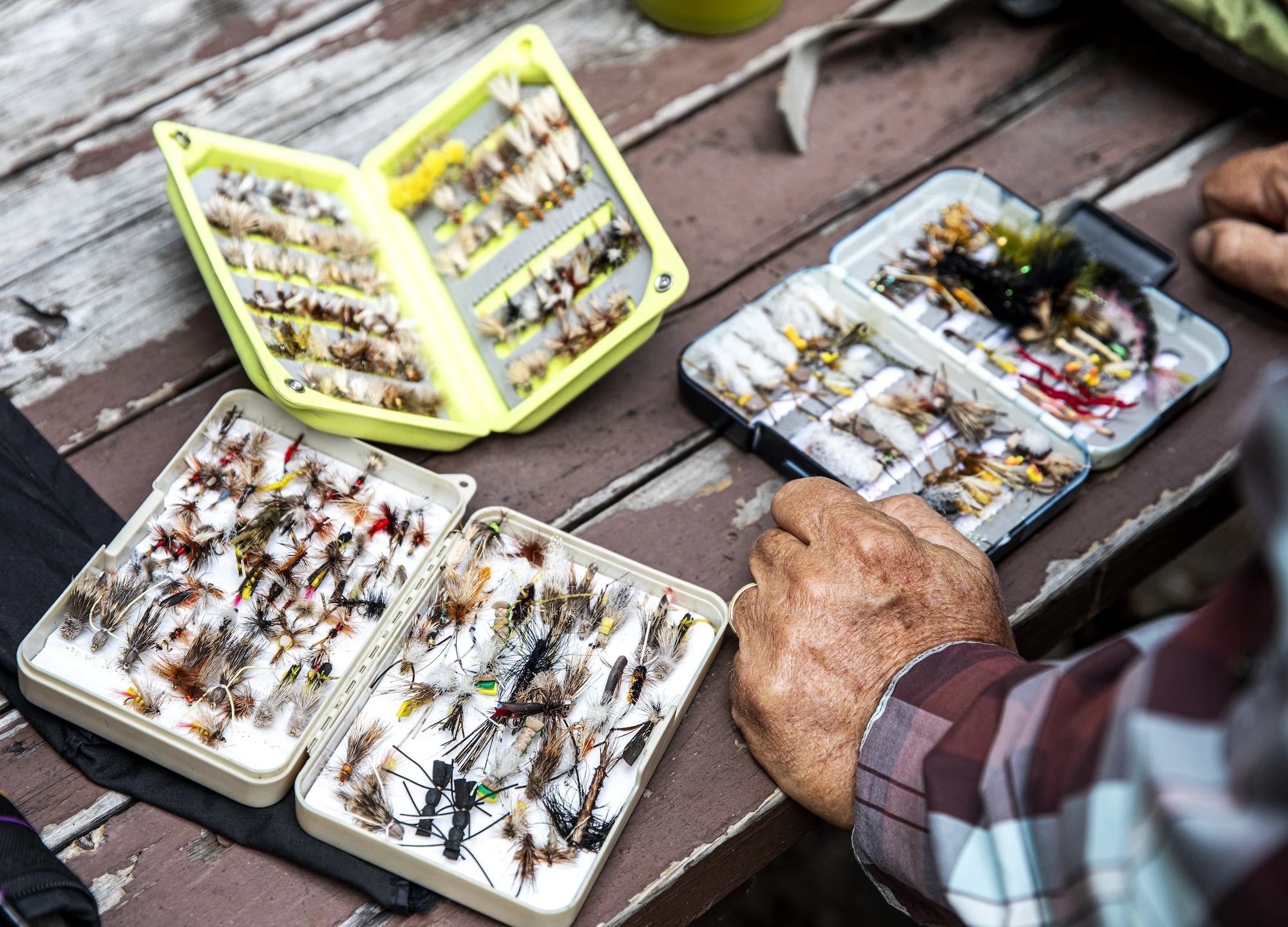
Hanlon sorts through boxes of hoppers and dry flies. Tom Fowlks
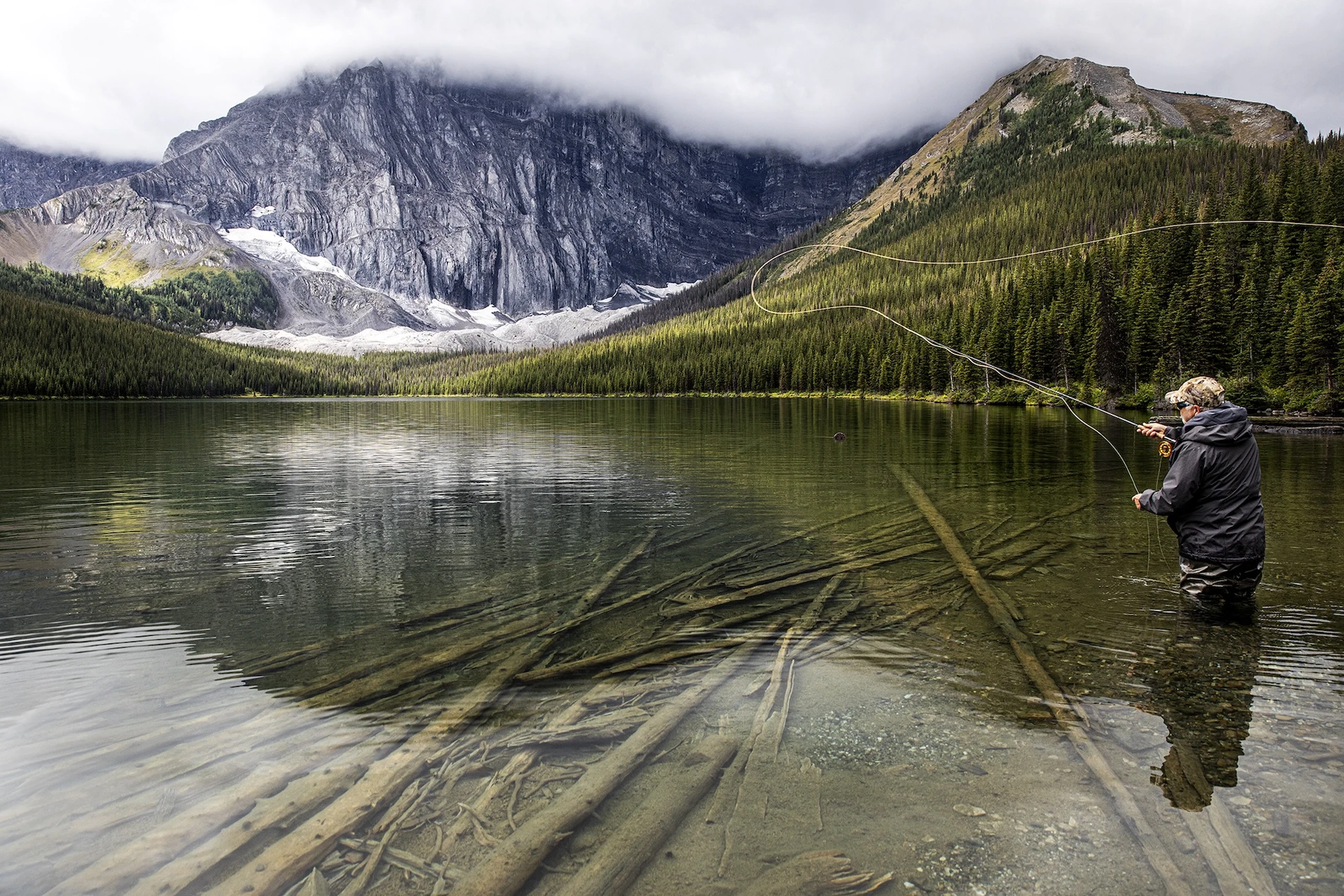
The author makes a fires cast to a cutthroat. Tom Fowlks
It’s also an approach with more than a century of heritage. In a 1921 article for the Journal of Forestry, a young Aldo Leopold codified for the first time what wilderness should look like in the modern era. He had the radical idea of setting aside large chunks of U.S. Forest Service lands as permanently protected landscapes. “By ‘wilderness,’” he wrote, “I mean a continuous stretch of country preserved in its natural state, open to lawful hunting and fishing, big enough to absorb a two weeks’ pack trip, and kept devoid of roads, artificial trails, cottages and other works of man.”
As we descended a forested ridge to the first high-elevation alpine lake on our itinerary, Hanlon explained how a -century-old idea retains relevance. Think about the notion of a landscape that is large enough to absorb horses, he said. “Horses give you the opportunity to penetrate more deeply than you can on foot, and if a landscape is that big, then all the other conservation values will be there too,” he explained. “And it’s those values that I’m really after, not the elk or sheep or trout.” And the barrier of effort to visiting such a place is a bonus and a saving grace. “The harder a place is to access,” he said, “the fewer restrictions you have to have, because the wildlife is not as vulnerable. To me, that’s the link between the past and the future of horse packing: conservation.”
Piggin String Theory
What makes horse packing possible is a time-tested mechanism by which you can load, strap, and secure hundreds of pounds of equipment, of various shapes and sizes—bedrolls, kitchen boxes, Dutch ovens, wall tents, raft frames, fishing rods, elk heads—to a horse and expect the load to stay put no matter the miles you travel or the terrain you cross. Packing up the next morning, I watched as Hanlon loaded each packhorse, covered the cargo with a heavy tarp called a mantie, and “threw” a one-man diamond hitch, as he called it, to lash down the bulky load. The elaborate rigging technique creates a sort of cargo net made of rope, anchored to six points but adjustable so it can cinch down the bulkiest items. Each packhorse is connected to another by tying a breakaway, or piggin, string from the rear of the packsaddle to the next horse’s lead shank. It’s a light connector that keeps the pack animals tethered to each other but will break if a horse falls or gets spooked and bolts.
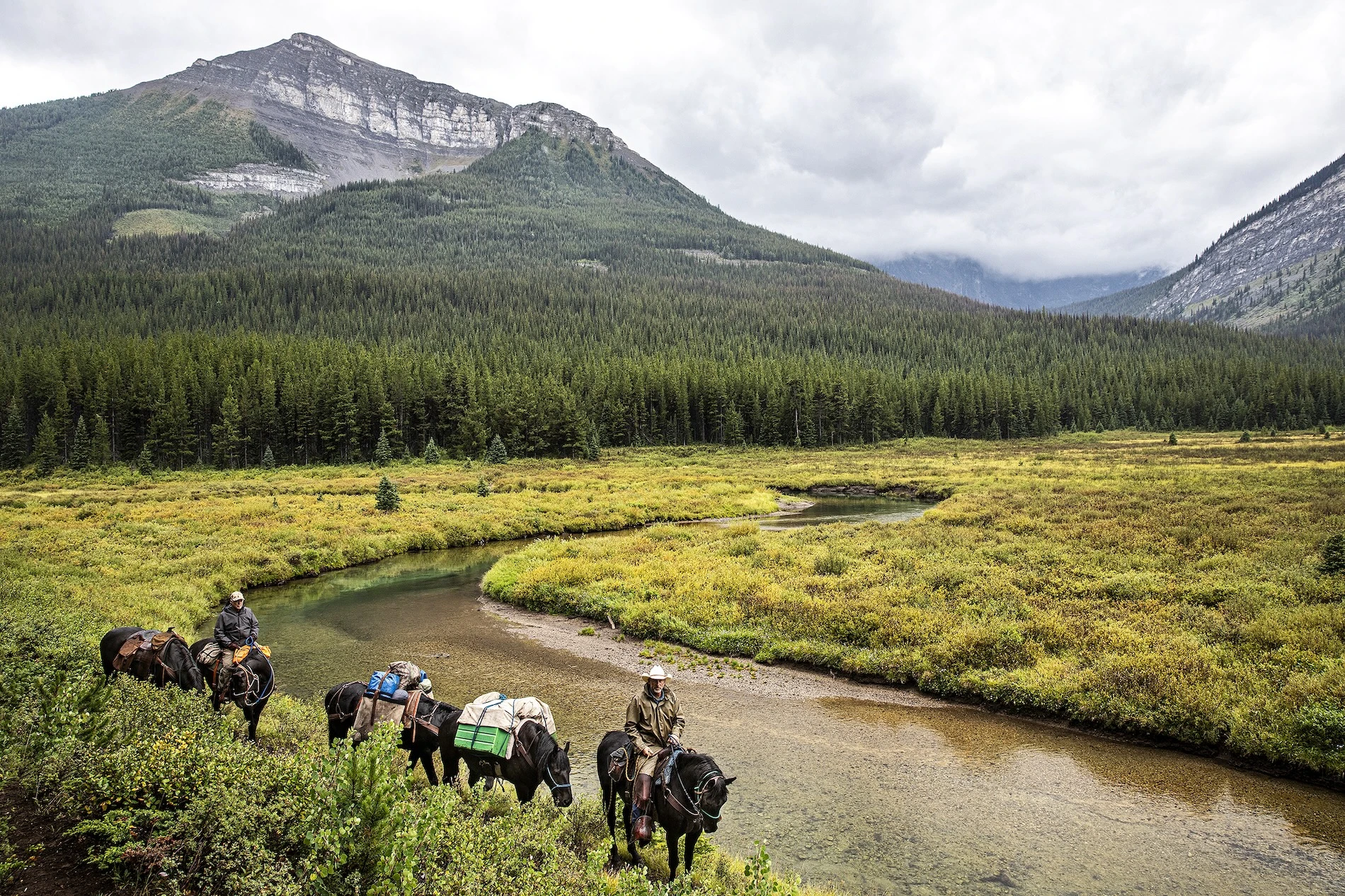
Hanlon leads a string of horses, and the author, through the B.C. wilderness. Tom Fowlks
With beasts burdened, we headed up the trail to a new lake and campsite. The route took us along the base of soaring bulwarks of stone—mountains like giant gray battleships—and we switchbacked through spruce and open valley glades. At times the trail was a corrugated surface, like old corn rows in a field, the undulations created by generations of horses that had placed their hooves in the exact same tracks.
The view as we neared the next lake and emerged from the forest was like having a door suddenly flung open to another platter of water still as glass, mountains and cliffs and timber reflected in its placid veneer. I could barely wait for Hanlon to hobble the horses before I got my hands on a fly rod.
Wilderness-lake cutthroat trout are a bit of an enigma. Typically, they are opportunistic feeders that aren’t too finicky about their daily grub. It’s finding them that’s the trick. Many alpine lakes seem nearly featureless, and the first step is to narrow down the equation from they-could-be-anywhere to this-is-exactly-where-they-will-be.
At the lake’s outlet stream was a few decades’ worth of downed timber that created a half-acre logjam. An offshore gravel mound was barely visible 50 yards from the shoreline, creating a broad trough where cruiser cutthroats, as Hanlon called them, tended to sortie up and down the channel, looking for a meal. I waded waist-deep into the lake and watched for incomers, like a bonefish angler on a saltwater flat.
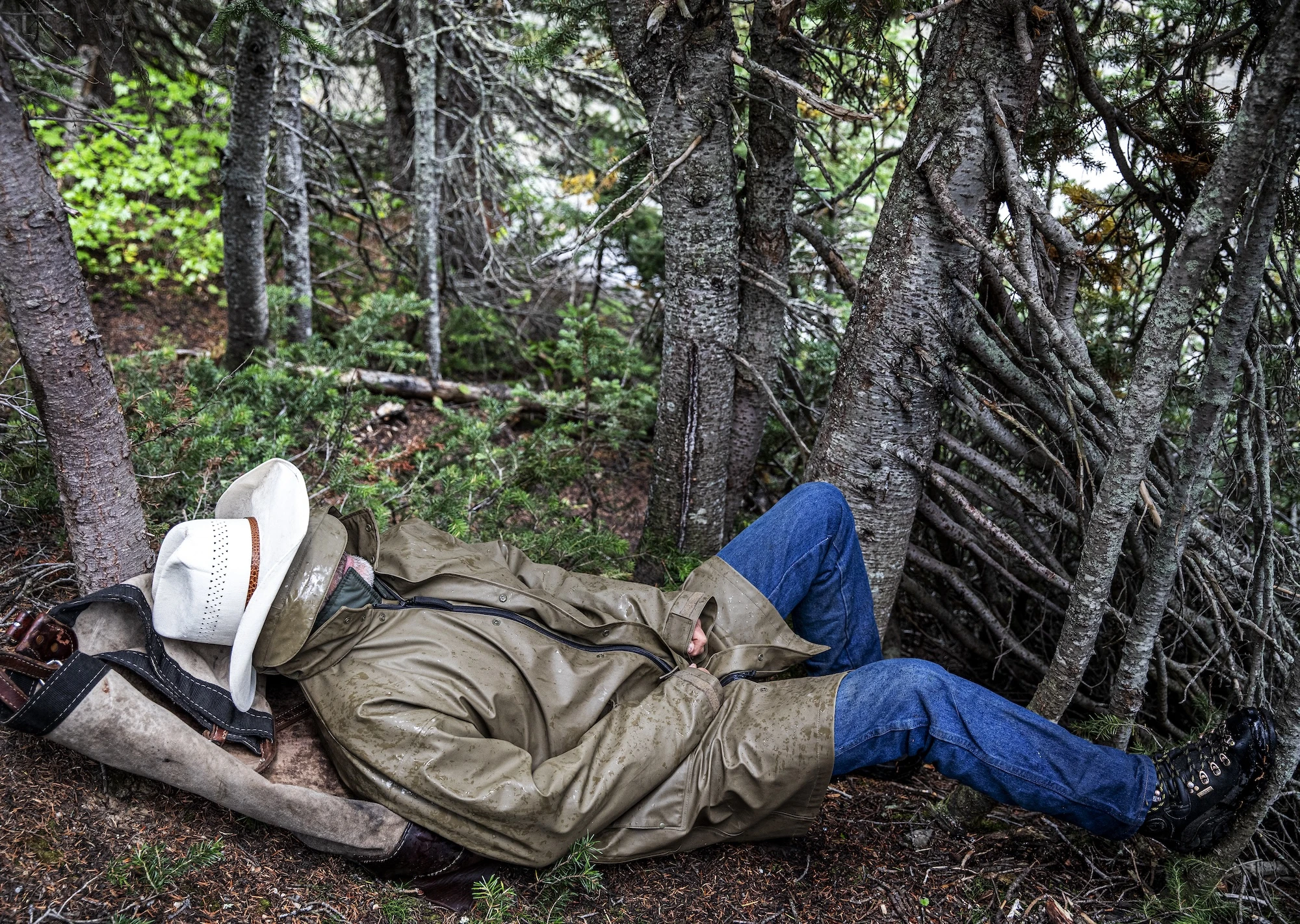
Hanlon takes a wilderness siesta. Tom Fowlks
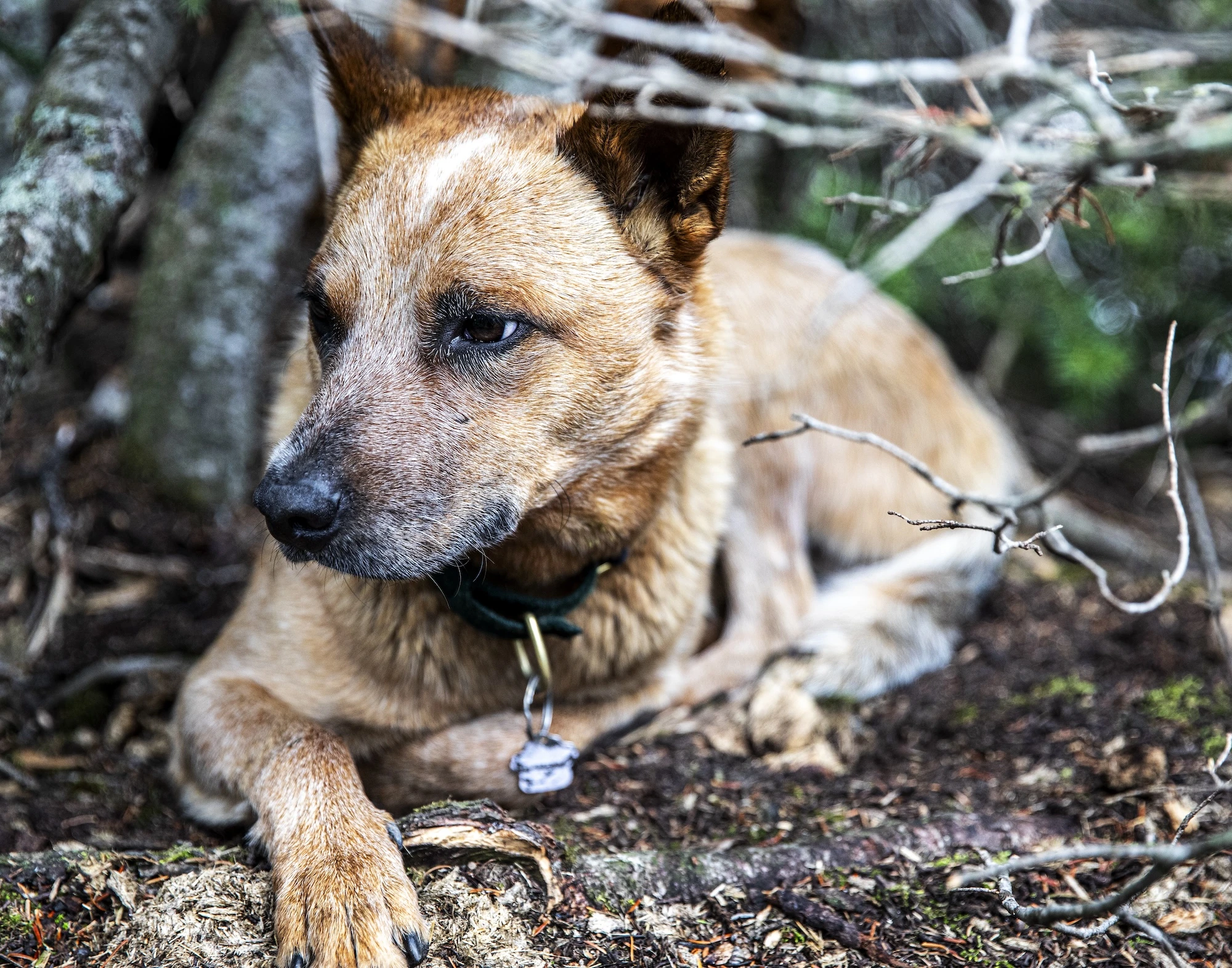
Hanlon's dog, Hitch, settles in for a nap, too. Tom Fowlks
And for a blissful hour, the fish came easy. I fan-cast along the trough, moving left to right, and with each fish caught and released I’d start on the far left again, to leave as much undisturbed water as possible for new cutthroats to move into. It all seemed to fit together: We’d worked hard to get here and would work hard to get out. We’d battled rough weather -every step of the way. I wasn’t taking for granted an afternoon of happy, willing trout. I remembered Hanlon saying that was one of the appeals of horse travel. He laments the helicopters and Argos that will pluck people out of the backcountry as soon as they tag out. “Those people are missing out,” he said. “There’s a deeper appreciation of wild country if you know going in that you’ve got to get yourself out of whatever you get into.”
I was just about to call it quits when a fish struck harder than any fish had yet. I knew immediately that it was my biggest fish by far, and whatever question that might have existed vanished when I realized in two seconds that I had little control over this trout in its home waters. In three seconds, it had wrapped the line around a sunken branch and broken off—before I could even exhale the great, sucking breath I took in at the moment of the strike.
It was the fish I wanted to end the day with, even though it was a fish that beat me at my own game. I met Hanlon back on shore, and there was just enough daylight left to collect half a handful of dwarf huckleberries to go with our pan--sautéed cutthroats. I found a moose tooth along the lakeshore, most likely from a -hunter--killed animal the previous fall, Hanlon figured, and I tucked it into my jacket pocket. After dinner, I fell asleep listening to coyotes howling across the lake, Hitch answering their calls, and the hobbled horses shuffling through the brush. It was hard to tell what century I was in.
Hurricane Cuttie
The next morning, we rose in the rain, ate eggs, bacon, and garlic Texas toast in the rain, and washed it all down with strong coffee in the rain. Then we broke camp for a long ride through the rain. Around midday, we crested a timbered ridge, and suddenly, the woods were filled with rushing water. We made a steep descent into the valley of another moraine-dammed lake, this one nearly encircled with dark firs, a white snowfield rising behind the trees to disappear in low clouds.

The crew kept a few trout to cook for supper. Tom Fowlks
The weather alternated between a steady rain and an old-fashioned downpour, so we strung up a tarp and hunkered down 30 feet from the water’s edge. For the next five hours, I would dash out when the rain slowed and fish in the dimpling rain until I couldn’t see the fly, then fish in the dumping rain until I couldn’t see the fly line before hoofing it back to the tarp. Wait. Repeat. The rain was nearly relentless. I never caught a fish. I never saw a fish.
But I was determined not to let the sun set on a fishless day. In the last of the light, with a short break in the rain, I trudged back out to the water. On my fourth cast, a cuttie took the fly in an explosive strike, and I knew immediately it was my best fish of the trip so far. I brought it to hand, marveling at its dark-copper coloration, and said, “Thank you, my friend,” as I released it back into the lake. I cast twice more before the rain started again, but they were lackluster efforts. I had what I’d come for, and I knew that sometimes it’s not a matter of skill or fly choice or length of leader or even luck. It’s just a matter of how long you’re willing to stand there in the rain, shivering, wet inside and out, determined to catch a fish.
Hanlon welcomed me back to the tarp with an E.O. Wilson quote. “The moral imperative of humanism is the endeavor alone, whether successful or not,” he said, “provided the effort is honorable and failure memorable.”
“The effort was honorable and I caught a fish,” I said, laughing and shivering in the cold. That’s when I stuck my hand in my jacket pocket and felt my knuckles scrape against the moose tooth. It was part smooth, part rough, like the scene before me, with the lake surface and the rugged, ridged mountain rising behind. I couldn’t help but think, This was the good-luck charm, the talisman that helped it all come together. On a whim, I lashed the tooth with baling twine from one of the horses’ piggin strings to craft a makeshift amulet and put it around my neck as a totem and for remembrance. E.O. Wilson likely would have scoffed at my superstition, but I was taking no chances.
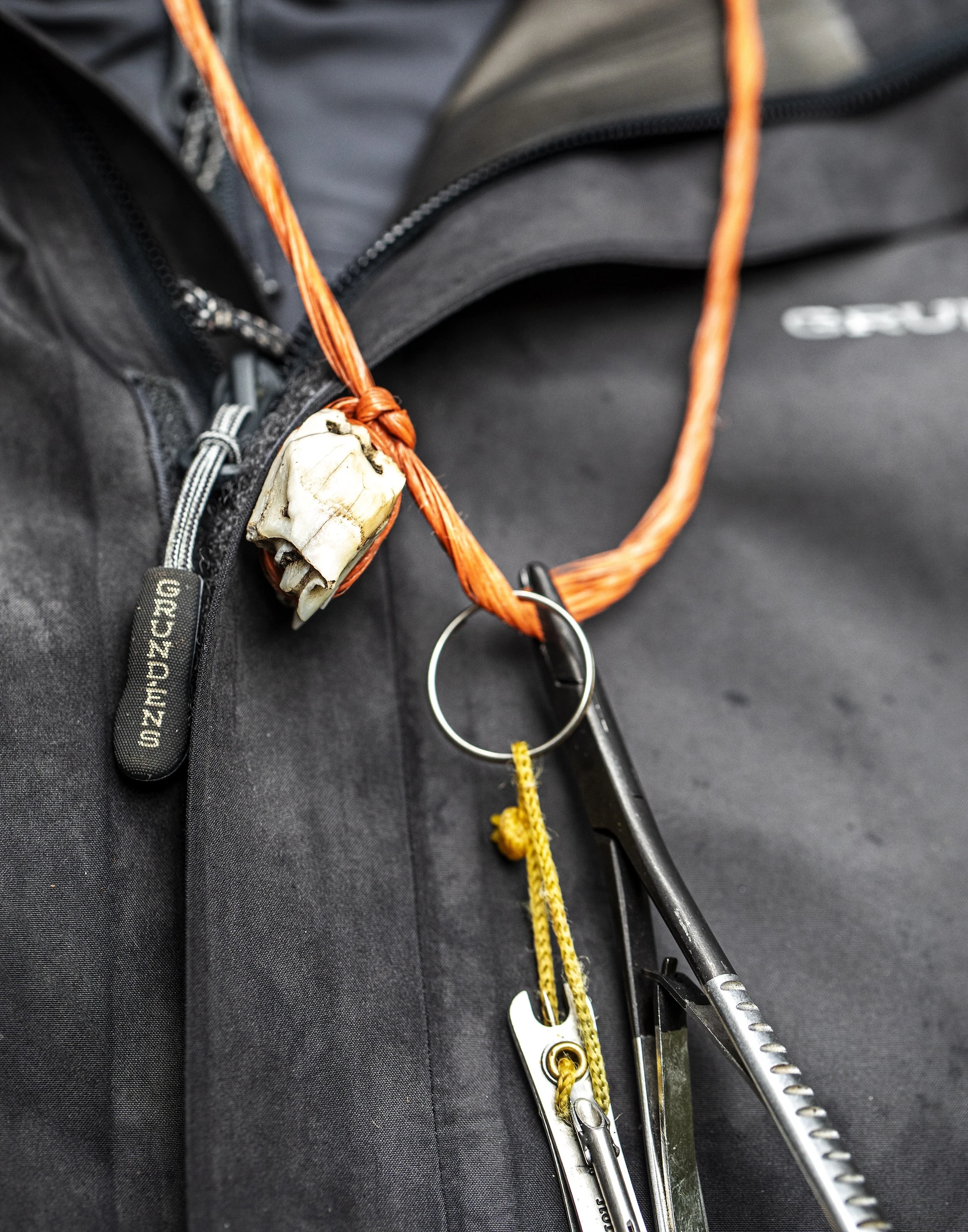
The moose-tooth amulet that became the author’s good-luck charm. Tom Fowlks
True Value
On our last morning on the trail, I woke up and lay still in the tent, listening to the horses nickering nearby. For the last few days, Hanlon and I had talked about the idea of wilderness, and what it means in a changing world, and how we can make decisions in the present that will ensure wilderness in the future. Some etymologists propose that the word -wilderness comes from an ancient phrase that translates to “the will of the land.” It requires land not dominated by the will and control of humans but tethered only to natural processes. I was hardly on an Aldo Leopold–sanctioned 14-day horse journey, but just a few days in the saddle had sharpened my understanding of how precious untrammeled country truly is. And I realized that we live in an era in which nothing is real if not on paper, delineated and defined. Today, wilderness is a construct of our bureaucratic state. It might not be dominated by the will of humans, but it can only be perpetuated by the same. We’re lucky to have folks like Hanlon standing in the gap.
I could hear a steady wind blowing through the valley. That meant it was going to be wonderfully clear outside—or not. I unzipped the tent door and opened up the rain fly. It was not wonderfully clear. I stuck my hand in my jacket and rubbed my moose-tooth amulet, then rolled out to start the day: Breaking down, packing up, riding toward home. And I hadn’t forgotten my date with a certain creek fish, at the base of a certain mountain.

Hanlon checks on the horses with Hitch leading the way. Tom Fowlks
On the ride out we recognized the spot. “You’re going for this, right?” Hanlon asked. I think he was as stoked for the attempt to close the circle as I was. I dismounted and pulled my fly rod from a pannier and hiked down to the creek. Downstream, I could see the spot I’d marked in my memory.
Just off my left shoulder, the scree slope rose nearly vertical. A fringe of creek-side firs blocked any backcast. I’d have to jerry-rig a presentation. I roll cast downstream and jiggled the tip of the rod, feeding loose line through the rod guides, letting the big fly float freely. It was crazy to think this was even possible. Jiggle and feed, jiggle and feed, 30 feet of line out and then 40 and then 50. The fly neared the downed trees and my heart raced. I fed the fly between two big trees that necked the stream down like a wildcat cartridge, and under a low branch. As it neared the trio of deadfall, I muttered to myself, “Not yet, not yet, not yet.”
Suddenly the fly disappeared in a -giant toilet-flush strike, the trout bashing the hopper fly and turning for home. So much for the quietude of a wilderness setting: You could have heard my howl for miles. At my feet, the cutthroat lay still, its gills flaring with the exertion of the fight. I wet my hands and held it in the water until I felt its flanks quiver and tense, then let it swim free of my fingers.
Who knows if it was my friend from four days earlier. Could there be any way to tell? But I’ll go to my grave fingering my moose tooth, believing in the improbable.
Which is one reason I would tell an outright lie the next day to the U.S. Customs and Border Protection agent as I crossed back into Montana. When he asked if I was bringing back to the homeland anything of value, I said no. But I had my moose-tooth amulet, an assortment of cutthroat-mangled Stimulator flies, and tent stakes still caked with British Columbia dirt. I had rain-splattered notes and memories of glaciers calving and cracking as I cast into pristine waters that had a good chance of remaining pristine for generations to come.
I wish I would have remembered to tell him about all of that—all of those things whose value is impossible to measure.


